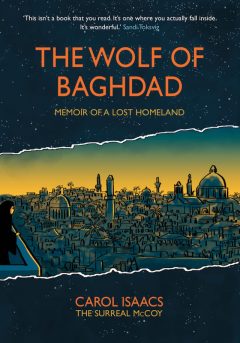Review: The Wolf of Baghdad (Myriad Editions)
Carol Isaac’s The Wolf of Baghdad is a thought provoking memoir of the former Jewish residents of Iraq and is an immersive and thought provoking read of the highest order.
 Publisher: Myriad Edition
Publisher: Myriad Edition
Writer/Artist: Carol Isaacs
Price: £16.99 from Amazon
The Wolf of Baghdad is a fascinating look at the the history of Jews in Baghdad. Told in a series of wordless panels interspersed with personal reflections from former residents of Baghdad’s Jewish population, the story is told as a kind of dreamlike memory, based around Carol Isaacs imagined experience looking back at her family history and her own memories.
The memory begins with Carol looking through old family photos and this inspires an idealistic reminiscence about life in Baghdad with the fictitious Carol wearing a traditional Jewish cloak, and being transported back to a time where Jews and Muslims lived together in harmony. But as the book progresses we see the family move out of the Jewish quarter, just at the time that the Nazis begin to hold more sway in the city and as a result European anti semitism begin to take hold. The memories begin to get darker and more harrowing as the Jews’ treatment in Baghdad gets worse, culminating in the mass exile of Iraqi Jews and a series of pogroms and public trials.
Wolf of Baghdad is a completely absorbing read about a period in history which may not seem obvious for documenting. However while the events of the time may not be unique, the message that it is trying to get across is still a very important one and resonates with similar stories of the period that a European audience may be familiar with. The idea that equality and tolerance can so easily be placed by bigotry and hate is a common theme throughout history, and this story takes that persecution concept and helps give it a personal focus, and unique perspective.
Visually it is a very simple story, feeling akin to Marjane Satrapi’s Persepolis for the way it uses simple characters and a very stylised black and white palette. This simple imagery is intertwined with glorious images of Middle Eastern culture and the Baghdad landscape, especially the scenes in the souk early on. While the characterisation may be simple the styling of some elements is wonderful and the use of the ghosts as representations of memory gives the book a very ethereal quality as well as a detached narrative with the character of Carol serving as a powerless observer rather than an active part of the story. The fact she cannot influence the events in any way makes the plight of her family even more potent and futile which makes the events seem even worse as a result.
The lack of dialogue may feel challenging at first, it ultimately makes you study the images more than you would otherwise. The narrative is not so complex or the concepts on each page too difficult in order to process without words, and in fact the juxtaposition of the quotes help you to really take on board what the visuals are saying and you find yourself reading the book at a much slower pace than as a result. As well as revisiting later to further your understanding.
Our only negative about the book is the use of the titular wolf as a concept throughout. Early on we are introduced to the idea that the wolf is used as a folkloric symbol against demons and while the wolf theme is brought through again towards the need, it didn’t really feel like a coherent part of the story in the way we would have expected for the book’s namesake. However this was not enough to distract from the story overall.
Like other books from Myriad this is a book which you might not instantly be drawn to but which, if you give it a try is incredibly rewarding and thought provoking. It is a stark reminder that bigotry is both nothing new or a solely European problems. That with tolerance all people can live together in harmony and prosperity, and that this is not an impossible ideal that with harmony and prosperity can co-exist.



September 29, 2025 @ 4:29 am
Your point of view caught my eye and was very interesting. Thanks. I have a question for you.